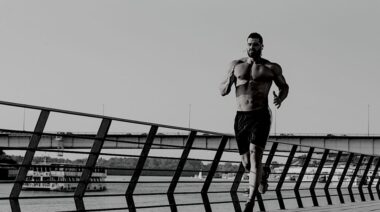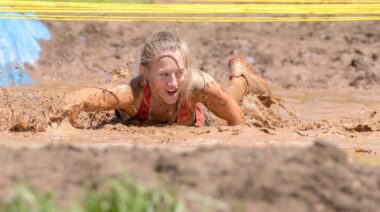“It doesn’t matter how beautiful your theory is, it doesn’t matter how smart you are. If it doesn’t agree with experiment, it’s wrong.”
A very common notion in training athletes who want to improve speed that one must press into the ground. In fact, this is so engrained in how we train people that we never, ever question it. It is a method employed by a huge number of coaches and trainers when trying to increase speed. It seems to follow Newton’s 3rd law of motion, in that when one body exerts a force on another body, the second body experiences a force equal in magnitude in the opposite direction. Basically, if you press back and down into the floor, then you move forwards and up, sounds completely logical.
The problem here is that sprinting doesn’t work like that.
The Myth of Triple Extension in Sprinting
Science has dealt a fatal blow to the triple extension theory. The triple extension or push off simply does not occur. It has been observed since the 1980’s that, during sprinting, the extensor muscle groups of the lower extremities (gluteus maximus, quadriceps, gastrocnemius, etc.) associated with this so-called triple extension are silent during the period of the stance phase in which they are supposed to be active.1 The musculature of the leg has been observed using intramuscular and surface electromyographical (EMG) electrodes, and Figure 1 below displays a visual representation of muscle activity during running.
Fig. 1: Muscular activity during each phase of running. The darker the muscle, the more activity. Reproduced with permission from Dr. Mick Wilkinson and Lee Saxby.
Calves
The gastrocnemius (calf muscle) is active during the foot descent, foot contact, and mid-support phases, but appears to shut down shortly after plantar flexion begins, just after mid-support. It is likely that the gastrocnemius is active to aid in foot stability in preparation for ground contact, and to control dorsiflexion during the mid-support phase by eccentrically contracting. A mere 6° of ankle plantar flexion from an available 33° is caused by a concentric contraction; simply not enough to create forward locomotion.
Quadriceps
The quadriceps become active about 50msecs after maximum hip flexion, yet knee extension begins 100msecs before maximal hip flexion. The higher the speed of gait, the more degrees of knee extension are achieved by the quadriceps. The quadriceps continue to contract concentrically until foot contact. Then, just as the gastrocnemius performed, the quadriceps eccentrically contract. This is to resist the maximal ground reaction forces and gravity, which at mid-support are applying force from below and above, squashing the runner. Once the mid-support phase is over, the quadriceps shut down.
Hamstrings
The hamstrings are by nature a biaxial muscle, crossing the knee and hip, and therefore create movement at both. Both groups of hamstrings are largely identical in terms of activity.1 The hamstrings likely undergo an eccentric contraction to control the rapid hip flexion during the forward swing phase as well as rapid knee extension during foot descent and foot contact. This could also explain why hamstring eccentric strength training plays such an important role in reducing hamstring injury risk factors.2 A lack of eccentric strength appears such a strong indicator of hamstring injury that even age and previous injury risk factors are decreased with increases in hamstring eccentric strength.3
Glutes
The gluteus maximus is assumed to play a vital role in sprinting, with most seeing this as a big part of the engine that drives us forward. Another blow to the triple extension or push off theory is that as the speed of running increases, the gluteus maximus shuts down earlier. The gluteus maximus is actually the first of the tested muscles to switch off on the stance leg after foot contact during sprinting. The magnitude of activity of the gluteus maximus increases during foot descent as the speed of running increases. It is therefore likely that the gluteus maximus controls the rapid hip flexion during the forward swing phase with an eccentric contraction, then a concentric contraction during the foot descent. In addition, it brings the pelvis back from a posterior tilt to neutral after the toe off phase. It should be noted that this control of torso angle during running is probably why humans have such highly developed gluteal muscles in comparison to other primates.4
How Sprinting Actually Works
Previously it was mentioned that the ‘push off’ theory involving triple extension seems a logical thought process when considering Newton’s 3rd law that each action has an equal and opposite reaction. Such reactions are visually represented in Figure 2, below. Ground reaction forces upon foot contact travel up and back in line with the virtual pivot point (see Figure 3), not the center of mass.5 The greatest ground reaction forces are seen during the mid-support phase, where the runner is squashed between the ground reaction force and gravity. But once the runner passes this midpoint, the ground reaction force rapidly drops, and thus creates insufficient force to propel the body forward.

Fig. 2: Ground reaction forces magnitude and direction. Runner is running left to right; greatest forces are applied at mid-support phase, and rapidly decrease as the runner falls forward. Reproduced with permission from Dr. Mick Wilkinson and Lee Saxby.
By now, the lack of a ‘push off’ is clear from the scientific literature. The extensor muscle groups switch off well before any triple extension can increase linear speed. In addition, ground reaction forces again provide insufficient force to propel the body forwards.
So what exactly is the driving force behind sprinting or indeed any forward locomotion?
The mechanism behind locomotion is all around us. You have interacted with it every second of your life—unless you have a habit of leaving the atmosphere. It’s gravity. Gravity is the driving force behind locomotion, via a rotational movement. Stand a pen up on your desk, let go. It fell over, and its center of mass fell in a certain direction. A rotational movement using gravity. An oversimplification in which lies a problem: the higher the angle of forward lean, the faster the center of mass will accelerate towards the ground, causing constant-acceleration running. This of course is not possible, and will certainly involve the runner picking themselves up off the ground.
The current leading theory regarding how forward locomotion works without constant acceleration is the virtual pivot point model. This model suggests a virtual, not physical, pivot point located above the center of mass. The exact location differs from person to person and can range from 5-70cm above the center of mass.5 As stated earlier, ground reaction forces travel back and up through this pivot point. During the mid-support phase, the ground reaction force is vertically aligned with the hip, center of mass and virtual pivot point. As the runner is squashed between gravity and the ground reaction force, some of this energy is stored in elastic tissues such as the foot spring and Achilles tendon.6 A gravitational rotation then occurs, with the passive release of stored energy from the connective tissues, creating forward locomotion. The virtual pivot point and center of mass form a pendulum, allowing the center of mass to swing underneath the virtual pivot point, creating a virtual pendulum. This creates a stable method of moving for an upright biped, stopping us becoming ‘top heavy’ by having most of the mass under this pivot point.

Fig. 3: A visualization of the virtual pivot point.5
What to Train Instead of Triple Extension
The research base provides evidence that sprint training involving triple extension drills by pressing into the ground may be ineffective due to a lack of push off phase in running. From muscle activity during varying speeds of sprinting, emphasis on rapid hip flexion from the psoas and iliacus should be placed as a priority. In addition, ankle complex training should mimic that which is observed during sprinting, i.e. to minimize vertical displacement of the center of mass and create joint stiffness. The ankle flexion angle changes only 8° in upon foot contact in sprinting, compared to 18° in jogging.1 Skipping with a rope could be such an activity.7 In addition, since eccentric contractions were observed in muscles previously thought to push off, ensuring eccentric strength, force absorption, and tendon elasticity is essential, using exercises such as Nordic hamstring curls, improving landing mechanics, and as previously mentioned, skipping with a rope.
Could your pre-race breakfast ruin your stride?
You Move as Well as You Eat: The LInk Between Food and Gait
References:
1. Mann, R. A., Moran, G. T., & Dougherty, S. E. (1986). Comparative electromyography of the lower extremity in jogging, running, and sprinting. The American Journal of Sports Medicine, 14(6), 501-510.
2. Opar, D., Williams, M., Timmins, R., Hickey, J., Duhig, S., & Shield, A. (2014). Eccentric hamstring strength during the Nordic hamstring exercises is a risk factor for hamstring strain injury in elite Australian football: a prospective cohort study. British Journal of Sports Medicine, 48(7), 647-648.
3. Opar, M. D. A., Williams, M. D., & Shield, A. J. (2012). Hamstring strain injuries. Sports Medicine, 42(3), 209-226.
4. Lieberman, D. E., Raichlen, D. A., Pontzer, H., Bramble, D. M., & Cutright-Smith, E. (2006). The human gluteus maximus and its role in running. Journal of Experimental Biology, 209(11), 2143-2155.
5. Maus, H. M., Lipfert, S. W., Gross, M., Rummel, J., & Seyfarth, A. (2010). Upright human gait did not provide a major mechanical challenge for our ancestors. Nature Communications, 1, 70.
6. Bramble, D. M., & Lieberman, D. E. (2004). Endurance running and the evolution of Homo. Nature, 432(7015), 345-352.
7. Brown, T. D., & Vescovi, J. D. (2012). Maximum speed: Misconceptions of sprinting. Strength & Conditioning Journal, 34(2), 37-41.






